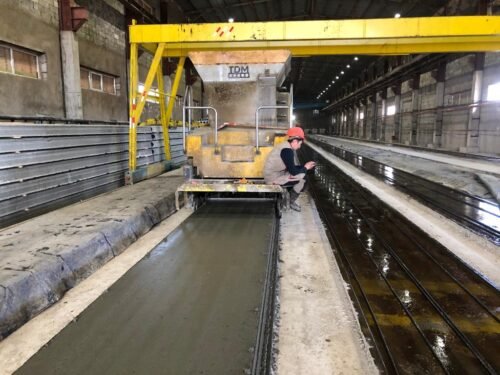The use of mouldless extrusion technology for reinforced concrete hollow-core slab production provides precast concrete manufacturers with a powerful competitive tool. It significantly reduces the production cycle time, improves the quality of concrete floor slabs, and optimizes costs — delivering real benefits to your investment and production efficiency.
How the Mouldless Extrusion Technology Works and Why It Is Efficient
The mouldless extrusion technology for reinforced concrete hollow-core slabs is based on the extrusion forming method: the concrete mix is fed into the machine’s hopper, then the extruder screws move the mix through a compaction module under high pressure, resulting in a slab with voids of a predefined shape.
In the system offered by TDM Engineering Oy, the machine includes a power unit, a hopper, and a compaction module. The range of product heights is from 120 to 600 mm (depending on configuration), and the casting bed width is typically 1200 mm (options up to 1500 mm or 2400 mm).
Mouldless forming means there is no need for traditional formwork — the process is simplified, costs of formwork materials and maintenance are reduced. The technology enables the production of slabs with high compaction, precise geometry, and high production speed — up to 3 m/min.
The process operates as follows: the concrete mix is fed by screws onto the casting bed, compacted, and continuously formed into a product of the desired length.
The technology is designed for producing hollow-core floor slabs and other precast reinforced concrete elements — such as beams and solid road slabs — all successfully manufactured using extrusion-based equipment.

Application Areas and Real-World Results
This mouldless extrusion technology for reinforced concrete hollow-core slabs is already in use across many countries and markets. TDM Engineering supplies equipment operating, for instance, in Europe, including extruders for slabs 1200 mm wide and 220–300 mm high with six voids. Installations are also in operation in Kazakhstan and the Middle East.
In a typical production line, casting beds of 1.2 m, 1.5 m, or 2.4 m width are equipped with the extruder; then the products undergo cutting and thermal curing. This allows the mouldless extrusion technology to be integrated into existing precast concrete plants without major reconstruction.
By adopting this method, the plant gains flexibility to switch between different slab heights, void shapes, and parameters — enabling it to efficiently meet custom specifications.
Key Advantages of Mouldless Hollow-Core Slab Production: Speed, Accuracy, Efficiency
Choosing the mouldless extrusion technology for reinforced concrete hollow-core slabs offers several core advantages:
- Higher productivity: forming speed up to 2 m/min dramatically increases output.
- Superior product quality: thanks to independently driven screws, new vibration beam design, and wear-resistant materials, slabs have precise geometry and high strength.
- Production flexibility: product height range from 120 mm to 600 mm, and bed width up to 2400 mm — adaptable to customer requirements.
- Simplified maintenance: absence of cardan shafts and gearboxes reduces maintenance and repair costs.
- Lower costs and fewer defects: no need for formwork means fewer auxiliary materials, less time for form changes, and fewer process interruptions.
As a result, the technology delivers clear benefits in operational efficiency, product quality, and overall profitability.
Choose Innovation Today — Comprehensive Solutions and Support from TDM Engineering
If you are seeking a solution to take your precast concrete slab production to the next level, the mouldless extrusion technology for reinforced concrete hollow-core slabs is exactly what you need.
We provide full support — from engineering consultation to delivery of equipment customized to your casting bed dimensions and product parameters.
Our company is an official partner of the manufacturer of mouldless extrusion equipment and offers installation, training, and maintenance services.
Contact us today — we’ll help you choose the optimal extruder model, set up your production line, and accelerate your path to profitability.
Don’t wait — turn your production into a competitive advantage with TDM Engineering’s mouldless extrusion technology and get your personalized offer now.
FAQ — Frequently Asked Questions About Mouldless Extrusion Technology for Reinforced Concrete Hollow-Core Slabs
1. What is a reinforced concrete extruder, and how does mouldless forming differ?
A reinforced concrete extruder is a machine that forms hollow-core slabs without using traditional formwork. The concrete mix is fed through screws and compacted under pressure, creating a finished product directly on the casting bed. This saves time, materials, and labor.
2. What products can be made using mouldless extrusion equipment?
The main product is hollow-core floor slabs of various heights and configurations. The technology is also suitable for producing solid slabs, beams, and other reinforced concrete elements made by extrusion.
3. What are the advantages of TDM Engineering extruders over other models?
TDM equipment features independent screw drives, modular design, high forming speed (up to 2 m/min), and minimal maintenance costs — ensuring consistent quality and long-term cost reduction.
4. Can mouldless extrusion technology be implemented at an existing precast concrete plant?
Yes. The production line can be easily integrated into existing facilities. Major reconstruction is unnecessary — it’s enough to install casting beds and the extruder, connect power and mix feed systems.
5. What surface and dimensional quality can be achieved with extrusion?
Due to thorough compaction and precise mechanics, the products have perfect geometry, smooth surface, and high concrete density — minimizing defects and improving durability.
6. Who provides installation, training, and service?
TDM Engineering offers a full range of services: delivery, installation, staff training, process setup, and ongoing technical maintenance.

